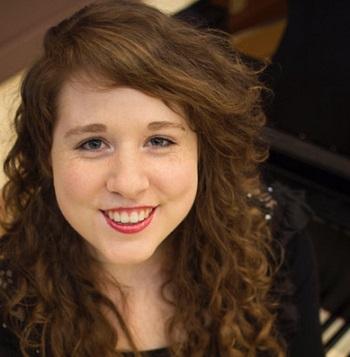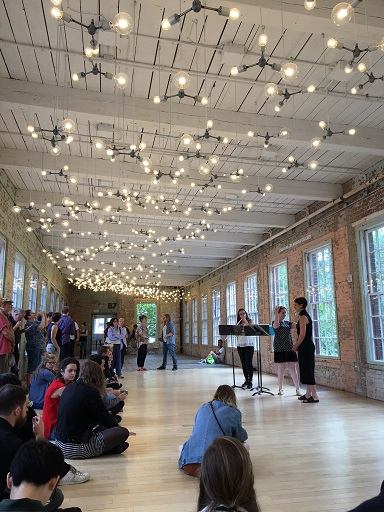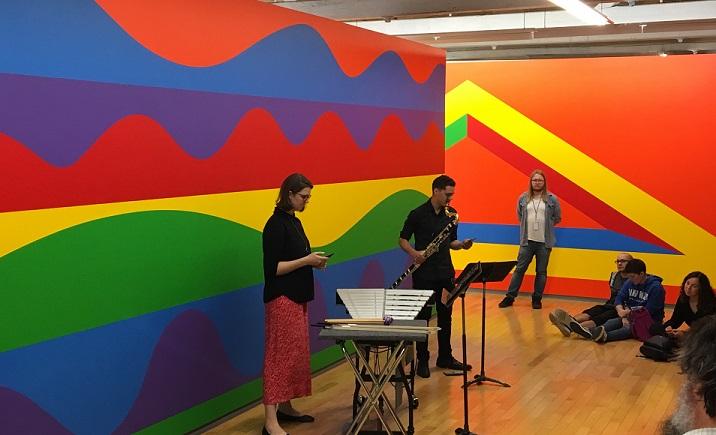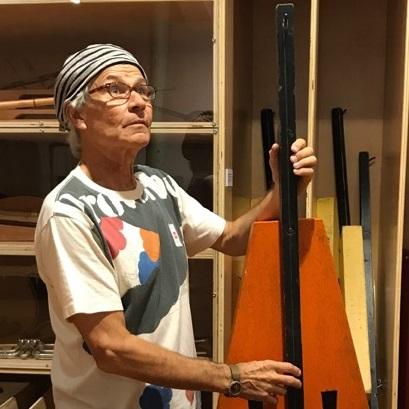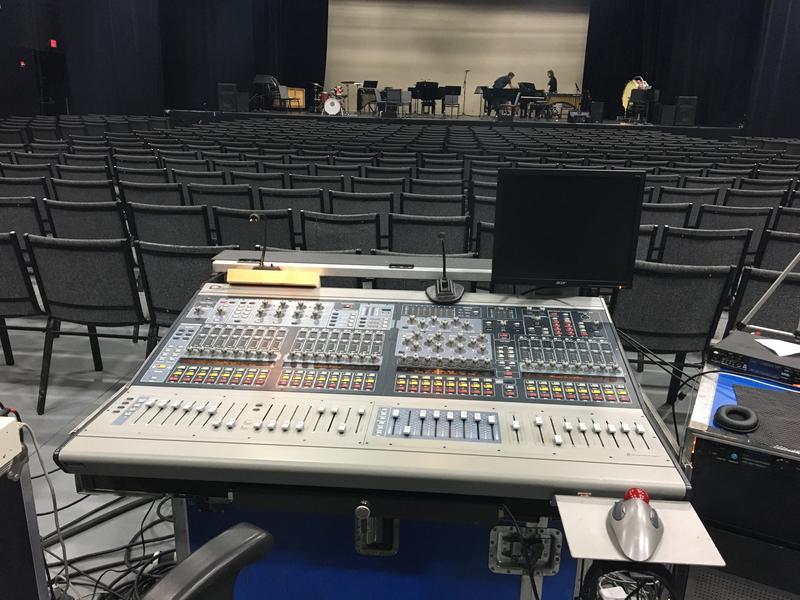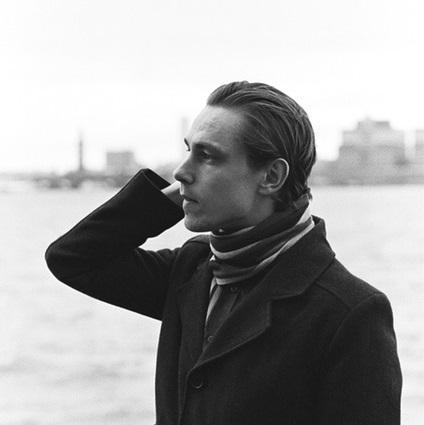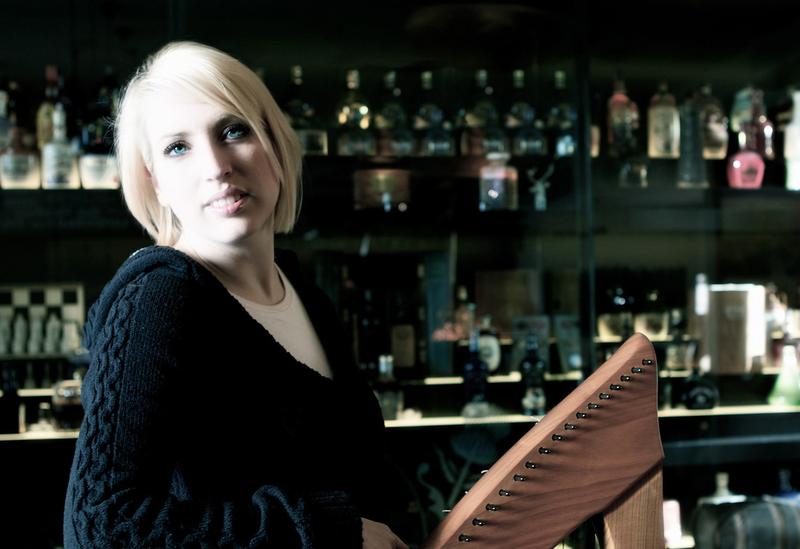
The Bang On A Can collective, which has championed new music since 1987, decamps every summer to Mass MoCA, the vast complex of former industrial buildings in North Adams, Massachusetts that now houses one of the country's largest contemporary art museums. Since 2002, Bang On A Can has hosted Fellowship programs for emerging composers and musicians - a way of allowing a younger generation of creators and performers to essentially grow up together. This year, for the first time, they included a Fellowship program for aspiring music writers, and invited me and the writer/musicologist Will Robin to serve as the faculty.
This week, we are reporting back from the Berkshires with our writing Fellows' impressions of the concerts, rehearsals, and unusual concert settings they're experiencing. It all leads up to the big event this weekend - the Bang On A Can Marathon at Mass MoCA, this year featuring composer Steve Reich. Follow our writers as they follow the musicians and composers who may be the next generation to change the sound of contemporary music.
-John Schaefer
Folk Songs from the Bang on a Can Festival
By Maggie Molloy
Ailie Robertson loves a good folk tale—and the spookier, the better. One of her favorites is “The Two Sisters,” a Scottish murder ballad recounting the tale of a girl who drowns her sister in the river. When the sister's body washes ashore, a townsperson crafts a harp from her bones and strings it with her golden hair.
A Scottish harpist and composer, Robertson was inspired by that very piece of folklore when she began writing music for this year's Bang on a Can Summer Festival. Robertson is one of nine composers from around the world who was selected to attend the annual festival this year in North Adams, Massachusetts. Last night’s concert featured world premieres from each of them, an explosion of wide-ranging works that embodied the eclectic nature of the festival.
For three weeks each July, the experimental music collective Bang on a Can brings together some of the most innovative young performers and composers in the field for an immersive three weeks of outside-the-box music-making. The festival is housed at the Massachusetts Museum of Contemporary Art (MASS MoCA), a sprawling complex of 19th-century mill buildings whose rich history is beautifully contrasted against the bold and brazenly modern art that now fill its rooms.
Robertson's new premiere was perfectly at home in this setting: the piece, titled Binnorie, draws connections between a 400-year-old Scottish folk tune and a modern day news story of a UK woman who murdered her sister last year. Conducted by faculty member Brad Lubman, the performance featured a mixed ensemble of voice, winds, strings, percussion, and a haunting sound collage of recordings from the UK police case.
"Often the things we think of as folklore are actually still so relevant today," Robertson said in an interview following the concert. "The themes in folk music are basically love and jealousy and war—and they always come around no matter what age we live in."
Binnorie captured the immediacy of these folk music themes but employed a more intricate timbral palette. Two female singers evoked the sisters on stage, singing the text of the original ballad in a ghostly modal melody amid a sea of string harmonics and quarter tones. Jet whistles and breathy murmurs in the flutes suggested the sister's desperate gasps for air, and musicians bowed the strings of two grand pianos with long yellow strands of twine that were reminiscent of her hair. Along the back of the stage four percussionists bowed marimbas and dunked cymbals in bowls of water. Woven throughout this gripping sound world were wailing police sirens, news reports, laughing children, river waves, and radio calls from the police. The result was a fresh take on a ballad that has inspired a number of modern reincarnations, including Bang on a Can co-founder Julia Wolfe’s Cruel Sister and Nico Muhly’s The Only Tune.
An earlier concert in the MASS MoCA galleries that afternoon featured another of Robertson's pieces: a string trio titled The Black Pearl that was inspired by Bach's Goldberg Variations and another folk tune called "The Pretty Maids of Galway." Performed in a dark room next to the muted landscape of a Patrick Bermingham oil painting, the piece evoked a similarly somber mood. Short melodic fragments of Bach's three minor key variations emerged from the rhythmic, circular bowing of the violin and viola, with the cello plucking a steady bass ostinato throughout. The effect was that of a distant memory, brief flashes of recognition shining through from just beyond our reach.
"I like music to have a narrative," Robertson said. "It doesn't have to be melodic, it doesn't have to directly tell a story, but there has to be some type of emotional thread that the audience can latch onto.”
Maggie Molloy is a music journalist, editor, and radio host at Second Inversion. She is based in Seattle, Washington.
A Museum That Opens The Eyes And the Ears
By Stan Tymorek
Scat singing rarely takes center stage. For the most part it tends to be a substitute for lyrics that a jazz singer resorts to after singing the words of a few verses. That’s one reason why Stephanie Orlando’s composition “Scatterbrain,” consisting entirely of scat singing, was a bold move. It was performed by a theatrical soprano and underscored almost syllable for syllable by a soaring flute.
Then there was the performance space: we heard this music below 150 specially fabricated LED fixtures suspended from the ceiling over an expanse of an 80-foot long gallery in the Massachusetts Museum of Contemporary Art. According to the MASS MoCA website, in this installation by artist Spencer Finch titled Cosmic Latte, lights are “arranged in the gently arching shape of the Milky Way as it is observed in the Northern Hemisphere in March.” Now scat was thrust into the cosmic spotlight.
These are the types of multimedia dynamics that happen at the North Adams museum every summer when the music collective Bang On a Can comes to town for a three-week festival of new music, presented by their Faculty and Fellows. MASS MoCA and Bang On a Can both specialize in large-scale experimentation: the museum in its 16-acre campus of the vast brick buildings of a former electrical plant. and the musicians with their signature 12-hour marathons and limits-pushing, seemingly limitless repertoire. When the composer and musician fellows select one of the galleries available to them, to present their work, the sheer scale and audacity of the art can’t help but affect how the audience hears their music.
After the single 30-minute slot in which“Scatterbrain” was performed, the museum-goers who heard it were led to one of the three floors filled with Sol LeWitt’s “Wall Drawings,” a quintessential part of MASS MoCA’s collection. There they heard “North Head,” by Tim Hansen, a piece for vibraphone and and bass clarinet commemorating, as vibraphonist Thea Hassen movingly explained in her introduction, the deaths of several gay men who had been murdered on a beach of that name in Australia. The duet sounded more contemplative than funereal, perhaps due to the spirit of LeWitt’s bold colored shapes—including a bull’s eye and a long wavy line that suggested the ocean in this context.
Contemplation abruptly ended when the audience moved on to another take on young men’s spirit, “as our Name Brand society,” an electrified improvisation performed on synthesizers and drums that did its damnedest to fill Mass MoCA’s largest gallery—almost a football field in size with 18-feet-high catwalks. This was the site of “The Archaeology of Another Possible Future,” by Liz Glynn, a sprawling collection of pyramid-shaped caves formed by factory pallets, multi-colored shipping containers and hospital-type gurneys. When the trio stopped playing we could hear a soprano perched on a catwalk, singing words on sheets of paper that she blithely tore in pieces and cast down. If the exhibit was a scene from the future, an audience member might think, the howling music was a valid protest against it, and why even bother to recycle the torn-up paper?
Having a Bang On A Can staffer lead the viewers to the widely dispersed gallery performances created a kind of indoor pilgrimage promising new discoveries. Our final way station was the “Lure Of The Dark” exhibit, a variety of artists’ responses to the mysteries of the night displayed in dimly lit galleries. The art pilgrims trekked all the way to the farthest one, where a string trio played “The Black Pearl,” by Ailie Robertson, which drew inspiration from Goldberg Variation #25 and a Scottish folk tune.
The Scottish-tune influence conjured up the image of a cottage dimly lit by a peat fire. And if you got close enough to one of the gallery painting’s placards, you could read that Patrick Bermingham’s scene of a moonlit path is titled “Midway on our path in life”— a reference to the first line of Dante’s Inferno. For a museum visitor without a Bang On a Can staffer to guide them through the maze-like MASS MoCA, a follow-up line in the poem would be more apt: “For the straightforward pathway had been lost.”
Stan Tymorek is a freelance writer from Madison, Wisconsin, specializing in the arts.
In Search Of Dan Rhode
by Sarah Lindmark
With my last bit of crumbling dessert, I sat down at a small round table in MASS MoCA’s café, Lickety Split. The man I assumed to be composer Daniel Rhode sat across from me, clean shaven, wearing a dark blue button-down shirt, with slick hair and a genuine smile.
He reached out to shake my hand. “Hi, I’m Philip Snyder.”
At that moment, it dawned on me that not only had I mistakenly asked the wrong person for an interview, but that I had somehow managed to start the interview before realizing it. At the Bang on a Can Summer Music Festival each July, MASS MoCA is teeming with bright, young musicians from around the world. They’ve all gathered to make friends and new music under the guidance of the Bang on a Can organization, a group of established musicians that have been writing, performing, and recording experimental music for over twenty years. I hadn’t considered the possibility that in the process of meeting everyone as quickly as I could in between concerts, rehearsals, and seminars, I might accidentally mix two of them up. Yet there I was, trying to be as pleasant as possible, talking to the wrong person.
In my defense, I had experienced quite the myriad of colors, sounds, and people earlier that day. MASS MoCA is packed with the work of some of the best in visual art (Liz Glynn, James Turrell, Natasha Bowdoin, and Sol LeWitt just to name a few), and combining it with a diverse array of music can be a little overwhelming. One of the concerts I attended had the audience walk to a different gallery space between each piece, making the hour and a half show feel similar to an art walk or a musical scavenger hunt. Called a lunch time recital, this type of multimedia experience is not new to either MASS MoCA or Bang On a Can. Nor is it new to composer Daniel Rhode, whose piece titled As Our Name Brand Society was performed at the recital.
Featuring drum set, keyboard, and synthesizer, Rhode’s As Our Name Brand Society had a distinct punk rock flavor that stopped suddenly when a vocalist appeared out of thin air on a raised metal platform - part of Glynn’s installation - around which the performance took place, reading something in a severe, urgent tone. She later tore her sheet of lyrics to shreds and sprinkled them onto the heads of the bemused audience. Although it was difficult to make out most of the vocalist’s text from my position below, her timbre blended well with the ensemble and added a distinctly human element to an altogether cold and hardcore piece. The only line I was able to make out occurred at the very end: “right in the middle of it comes a smiling mortician.” I was left both bewildered and fascinated - the piece stopped just as suddenly as it began, and I couldn’t keep myself from laughing.
The second of the two Rhode works was introduced by the composer: in pre-performance remarks, he stated that he’s particularly fascinated by the Liz Glynn gallery and “how our humanity changes as we go from working with physical objects to swimming in some digital ether.” His words clarified some of my suspicions about As Our Name Brand Society, and the piece that unfolded after his short preface continued to pull back the curtain. Titled Zero System, the piece is about “human movement.” He said, “I’m using some of the ideas from my electronic music, but really trying to make it human. You’re going to hear a lot of these mechanical rhythms that come together in some giant human, robot whole.” With driving, interwoven rhythmic lines punctuated intermittently by the piccolo and xylophone, the composer’s mechanical influence in Zero System is unmistakable. The ensemble dropped out periodically, leaving the pianist alone with a repeated polyrhythmic figure. The human element fought back in the low tones of the bass, but was eventually swallowed by the rest of the ensemble once again. Despite having little programmatic context outside of a single forty-five second pre-concert talk by the composer, Rhode’s two works felt thematically linked. Both grapple with hard-hitting subject matter – our dependence on technology and our materialistic culture – and both are musically drawn from noise rock. This link led me to my desire to interview him and spend more time engaged with his work this week, even if it meant handling a few bumps along the way.
After fifteen minutes or so of excellent conversation from flutist Philip Snyder, I decided to close out the interview with, “One last thing – I’m looking for a composer by the name of Daniel Rhode for another interview, do you know where he might be?”
Sarah Lindmark is currently working on a Master's Degree in Musicology at the University of California, Irvine.
His ears decide what we are hearing: amplifying the Bang on a Can Summer Music Festival
by Lasse D. Hansen
"Okay, what do you guys need to be different?," sound engineer Andrew Cotton asks from the back of the empty hall as soon as the ensemble stops playing. The time is 3:30pm, Monday afternoon, and it's the first day of the final week of the three-week Bang on a Can Summer Music Festival.
For the past two weeks, the musicians have worked intensively with the festival's nine composition Fellows at the Massachusetts Museum of Contemporary Art campus to realize nine new works written for the occasion.
Right now, eight of the Musician Fellows are on stage, rehearsing Zero System - a groovy piece by composition Fellow Daniel Rhode consisting of waltzing melodic fragments - for the last part of the process: the sound rehearsal for the World Premiere Composer Concert in just one hour.
Cotton’s fingers rest on ten of the 32 faders on the extensive mixer desk at which he is seated. On a small monitor screen he can follow the sound levels of all the individual instruments and with a microphone he is able to speak directly to the musicians on stage. Most of the time, however, he shouts through the hall. It works perfectly fine.
The sound engineer has been working with the Bang on a Can All-Stars since 1996, and he is introduced as "the seventh member of the band" by Bang on a Can co-founder Julia Wolfe. "It’s a long-term relationship," she points out.
"A lot less guitar, please," one of the percussionists answers. "And if possible, can I get a little more bass clarinet?" At this time, it's not so much about actually rehearsing the pieces as it is about setting the right levels of amplification for the musicians on stage.
"We should probably kill the monitors for this," the clarinetist and faculty member Ken Thomson suggests as they decide to move on to the next piece on the program, Heron and the Bell by composition fellow Guusje Ingen Housz. This means that Andrew Cotton gets a brief but much needed break on a very long work day.
The piece is about simplicity, stillness and movement, according to the Dutch-born Housz, and for the entire piece the two percussionists are moving calmly and almost processionally across the stage. One is playing a singing bowl, the other is playing shackles.
The piano and bass players join by adding simple, meditative harmonies to the percussion, quickly followed by woodwinds playing short two-note melodies. The piece is slowly assembled from these musical elements, both free floating and structured like planets in a solar system.
In a brief moment of silence an unexpected creaking sound appears. First, it is not clear where the sound comes from, but it quickly turns out that it is the stage floor that creaks, amplified through the microphones on stage. The musicians interrupt music to discuss different solutions, and Cotton is called to the stage to help. So much for that break.
The solution, he says, is to move the percussionists to the floor in front of the stage, along with the strings that are taped to the floor to guide the musicians' walk. "Can we move the stairs?," one of the musicians shouts through the room, and three stage hands quickly enters to move it.
"I just broke my golden rule," Andrew Cotton says walking across the room to take his seat again with the audience now entering the room. "I changed something five minutes before the concert."
Now another unexpected sound appears, this time from above. From the roof, a deep and soft rumble moves down the walls, amplified by the whole room. The musicians are looking up. A member of the audience turns to me, saying "Wow, the rain on the roof sounds amazing!" There is no way to fix that. It will be part of the concert.
Lasse D. Hansen is a Copenhagen-based composer and writer, whose latest performances includes the theatrical fantasy Face the Music at the 2018 MATA Festival in New York. As a music journalist he is interested in the mysterious process of doing creative work.

